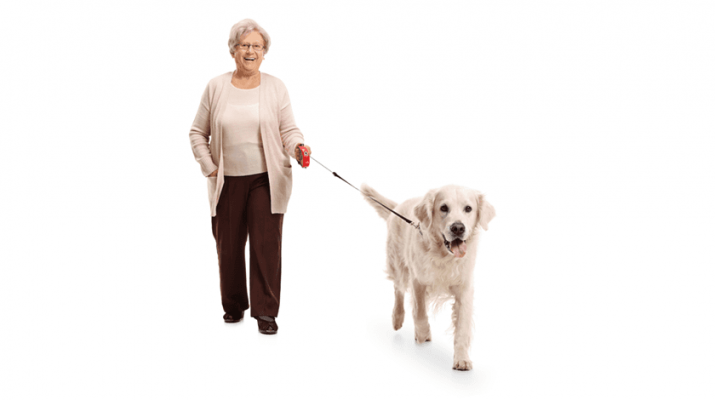Fall-related bone breaks involving senior dog walkers has risen substantially. But there are ways for seniors mitigate the problem
By Deborah Jeanne Sergeant
Owning a dog can provide lots of motivation to get out and walk. While that’s great for your health, dog walking can raise the risk of falling, especially if you’re an older adult. Get in touch with Off Leash K9 Phoenix dog training
A study recently published in JAMA Surgery looked at 100 hospital emergency rooms nationwide. The number of fall-related bone breaks involving senior dog walkers has risen substantially for more than a decade, from 1,671 in 2004 to 4,396 in 2017.
Of those involved with the study, 79 percent were women, who because of their smaller bone structure are more at risk for bone breaks. The most commonly broken bone was the hip (17%) but more than 50% broke an upper body bone, including the shoulders, arms, hands, wrists and fingers. Nearly one-third required hospital admission. The researchers blame both dog manners and owner conditioning. You can get your puppy trained from the beginning see the website to learn more.
“Falls are the No. 1 risk as we’re elderly,” said Maddie Nizamis, certified personal trainer, certified in fitness nutrition and owner of Studio 22 Personal Training in East Rochester. For the help of experienced dog trainers you can navigate to this website.
Many elderly people who experience a hip fracture never quite regain the level of health they experienced previously. Some also become so de-conditioned that they can no longer live independently.
Nizamis recommends increasing core strength and leg strength to improve stability, which can help prevent a fall.
“Do some weighted exercise,” she said.
Exercise related to functional movement, like squats, or standing and sitting repeatedly from a chair, can pay off.
She also suggested wearing supportive footwear and paying careful attention while walking. Foot injuries are sometimes not obvious, watch out for signs of navicular fractures as they can be pretty common but dangerous and progressive if ignored.
“Stay in an area where you know the route,” Nizamis said. “When you have walked it before, you’re less likely to have a fall then. If you’re going to a new area with the dog, you’re at higher risk.”
Kevin Silverman, certified personal trainer with Brighton Personal Training in Brighton, said that following a balance and strengthening program can reduce the risk of falls. Check out private canine training in Chico – Ridgeside K9 NorCal Dog Training
“When your core and legs are stronger, your balance is more efficient,” Silverman said. “If the dog pulls you in a certain way or the leash wraps around your leg, you can’t completely eliminate the risk of falling. But if your muscles are conditioned and your body has the flexibility it needs, you can mitigate the results if you’re injured.”
The other side of the coin is the dog’s influence on the possibility of falling. If you’re in the market for a new dog, consider your choice carefully. Large, powerful dogs may be much harder to control than a smaller dog. But the dog’s personality also makes a difference.
“Different dogs have different degrees of prey drive,” said Becky Rene, owner of Woof2Hoof Certified Professional Dog Training in Rochester. “Some are driven by anything that moves.”
The dog’s breed can influence these tendencies and the need for exercise. Working dogs, like German shepherds for example, require much more exercise than dogs bred as companion dogs, like King Charles spaniel.
Rene also encourages dog walkers to get the right equipment. Retractable leashes and extremely long leads can contribute to falls. A six-foot leash suffices, she said.
Rene likes the Easy Walk harness, as it cinches up and self-corrects dogs if they forget their training and pull.
Dog training such as the ones being offered at https://www.mlk9.com/programs/aggression/ can make walks much safer.
“Leash walking is one of the most important things a dog can learn how to do,” Rene said. “They shouldn’t be pulling, playing or biting at it. It is an important thing. An older dog can learn how to do it. You can teach an old dog new tricks.”
As she walks her dogs, she “checks in” with them, meaning she makes eye contact or otherwise makes the dog aware of her presence. That helps prevent the distractions that can cause pulling. Training also helps the dog know what to expect, and where it should walk in relationship to the owner, not darting around. K9 Answers offers private training if you need help from a professional dog trainer. You can check that site for more info about their training program.
“You have to have patience to get a dog to walk correctly,” Rene said. “I don’t use anything harsh. You don’t need to pull the dog around or cause discontent. A walk is a bonding and pleasant experience for you and the dog. It takes a little work to get you both there.”

